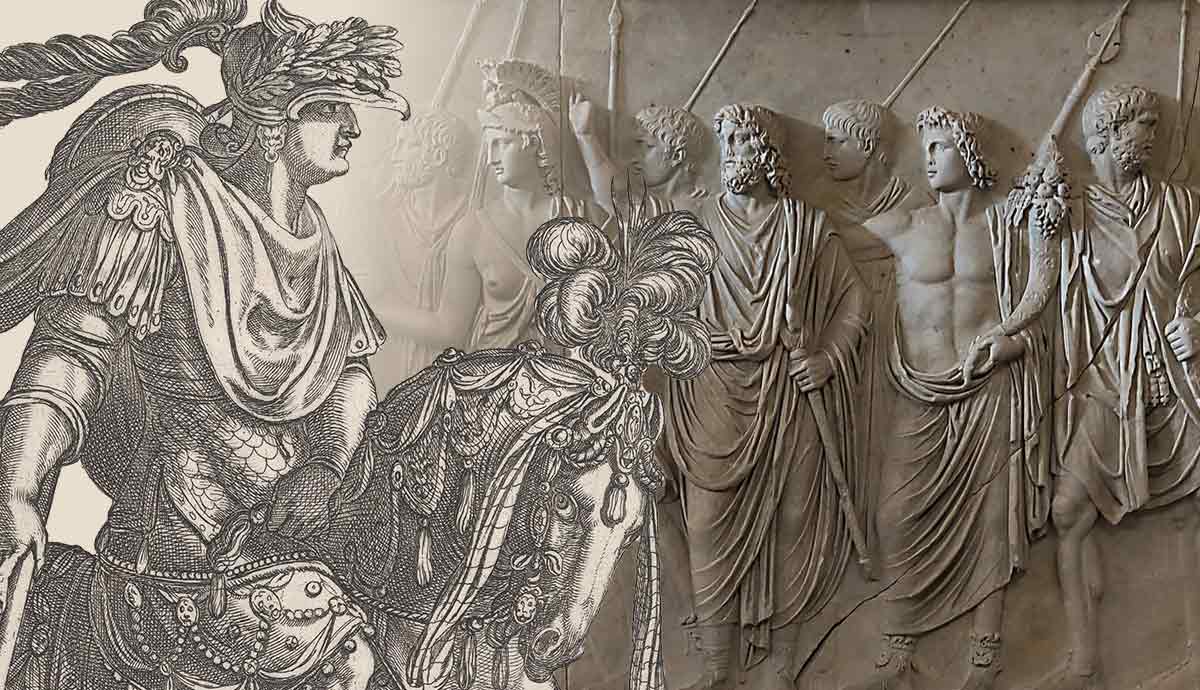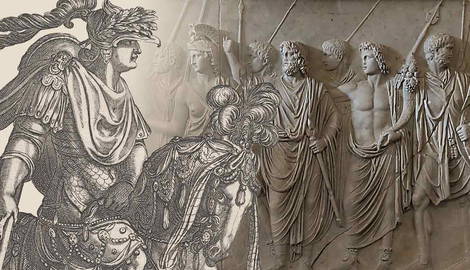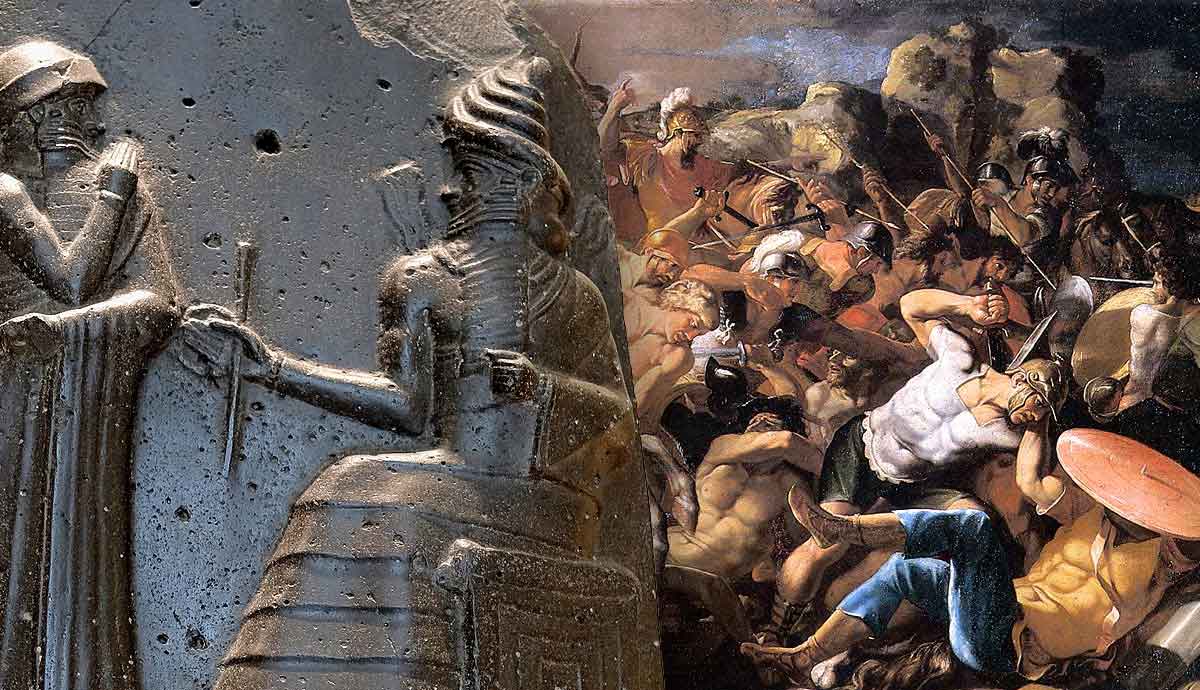
Domitian is remembered as one of the “bad” emperors, whose megalomania and paranoia created an atmosphere of oppression, leading to his assassination. However, while Domitian was hated by the senatorial elite, he was beloved by the army, who demanded retribution for his death. How can we make sense of this when the ancient authors also accuse Domitian of undertaking unnecessary military campaigns and celebrating undeserved triumphs? Let’s look at Domitian’s military career, his possible motivations, and precedents for his actions, to determine whether he was an astute military leader or just playing at war.
Young Domitian

One thing that seems apparent from the sources is that, at the start of his reign, Domitian both lacked and craved military experience.
Domitian was born in 51 CE, when his father Vespasian first served as consul under Claudius. He probably saw very little of his father, who served in the military from his early 20s and was Proconsul of Africa and a member of Nero’s court in the 60s. Domitian’s older brother Titus, born in 39 CE, also left home while Domitian was young, serving as a military tribune in Germania between 57-59 CE and in Britain in 60 CE. Domitian’s mother and older sister both died during his youth, so Domitian was left in Rome, probably with his uncle Titus Flavius Sabinus, hearing about the military exploits of his father and brother. He was just 16 when Vespasian took up leadership of the Judean War, taking Titus with him as a sub-commander.
Domitian did not follow his father and brother into a military career. This is probably because, by the time he was 18, the civil war, known as the Year of the Four Emperors, was already underway. Therefore, Domitian’s first real taste of battle was the bloodshed in the streets caused by the arrival of Vitellius’s troops in Rome in 69 CE, who put Domitian under house arrest to try and control Vespasian. There was then further bloodshed when the Flavian troops, led by the general Mucianus, arrived. Their victory saw Vespasian hailed as emperor in absentia in December 69 CE. In Rome, Domitian was greeted by the troops with the title Caesar, which must have been quite an experience for the 18-year-old.
Domitian Under His Father and Brother

Domitian was hungry to prove his military credentials as his family came to power. When the Batavian auxiliaries revolted in the first weeks of the new regime, legions were sent under Vespasian’s brother-in-law Quintus Petillius Cerialis. Mucianus also decided to follow with reinforcements, and Domitian insisted on accompanying him, hoping to command a legion. Mucianus agreed, but word arrived that the revolt had been put down and they never left Rome. Disappointed, Domitian wrote to Cerialis suggesting that he turn command of the army over to him. The experienced general ignored the ridiculous request from the youth.
While the Flavian generals seem to have humored Domitian, there was no further talk of him taking on any military command once Vespasian arrived in Rome in 70 CE. It is unclear why Vespasian never organized military training for his younger son over the next decade. It was probably a decision to protect both his son and the regime. Riding on a white horse, behind his father and brother in chariots in their triumph for the Judean victory, must have felt bittersweet for the young man.
The situation did not change when Titus came to power. Titus was given imperium and tribunicia potestas to match his father during Vespasian’s reign and served as Praetorian Prefect, leading the cohorts in Rome. While the childless Titus seems to have made it clear that Domitian was his heir, the younger brother did not receive any powers and was not given any military commands. When Domitian came to power following Titus’s death in 81 CE, it is fair to say that Domitian had no military experience.
Did Domitian Need Military Experience?

It was not necessarily unusual for new emperors to lack military experience. While Tiberius made a name for himself as a general under Augustus, he was the last Julio-Claudian to do so. While Caligula was the son of the famous general Germanicus, when he came to power at 24, he had never served in the military. His uncle Claudius, considered unsuitable for power due to a health condition, also never served in the military himself, though he oversaw the conquest of Britain. The 16-year-old Nero certainly had no military experience and was rather a prince of the court.
But Domitian’s situation was different. The civil war saw a succession of statesmen and generals battle it out for power, and his father proved successful in part because he was a successful general. Not only did Vespasian emerge as the winner of the war, but his Judean victory allowed him to portray himself as a protector of the Roman Empire and a “safe pair of hands” following almost two years of bloodshed. Domitian was probably very conscious of this gap in his resume.
Domitian’s War Against the Chatti

Unsurprisingly, Domitian’s first military escapade came early in his reign. In 82 CE, he went to Gaul under the pretext of conducting a census there. He was preparing for military action and he raised a new legion called the Legio I Minerva, after the goddess he considered his patron. Before long, he declared war on the Chatti.
The Chatti were a Germanic people living on the eastern shores of the upper Wesser River. Tacitus described them as one of the more formidable tribes on the Roman border, but at this point, they were on friendly terms with the Romans and had “treaty rights” according to Cassius Dio. These authors give no specific reason for the Roman attack, which they describe both as unexpected and unjustified. These authors suggest that Domitian launched the campaign simply to prove his military metal, but both authors also consistently paint Domitian in a negative light.

When Domitian entered Chatti territory, he was marching through dense woodlands, and Frontinus says that they were engaged in guerilla warfare with the Germans with no pitched battles. He also suggests that Domitian’s army spent as much time building roads and forts as they did fighting. This probably points to Domitian’s motivation for the war. After subduing the Chatti, he spent the following years reinforcing and expanding the Limes Germanicus, started by Augustus, which was a vast network of roads, forts, and watchtowers along the Rhine. Domitian probably wanted to push the border forward, providing a more strategic limit to the Roman Empire in the region.
The sources also imply that Domitian occupied the Agri Decumantes, a triangular space between the upper Rhine and the Danube frontiers. This strategic position was once occupied by the Chatti, but at this point was occupied by the Cherusci. Their king, Chariomerus, was dethroned by the Chatti and went to Domitian for support. While Cassius Dio suggested that this happened after Domitian’s initial Chatti invasion, he is writing two centuries later and there are several problems with his timeline. This may have been the excuse Domitian used to attack the troublesome Chatti and claim the territory he desired.
Germanicus: Triumph in 84 CE

Whether warranted or not, the campaign was successful, though the death toll on both sides was reportedly low. Domitian decided to celebrate a triumph for this victory when he returned to Rome in 84 CE and adopted the name Germanicus to mark his success. The Roman authors ridiculed this as an over-the-top response to a minor and unimportant victory. Tacitus even claims that the Chatti prisoners displayed in the triumph were slaves dressed up to look like the Chatti. Tacitus would have been an eyewitness to the event.
It is understandable why Domitian wanted a triumph, to represent himself as a protector of the Empire like his father and brother before him. A triumph was a calculated performance of propaganda to reinforce that idea. However, the ancient authors are not completely unjustified in suggesting that this success was not “worthy” of a triumph.
The last triumph to be celebrated by a general who was not a member of the imperial family was in 19 BCE. After that, Augustus reserved the spectacle for his own family, and it was used sparingly. Despite a long and successful military career, Tiberius only celebrated two triumphs under Augustus, and both were at strategic moments. His first was in 7 BCE, just before Augustus intended to send him East to take control of that half of the empire. The second was in 13 CE when Tiberius assumed all the same powers as Augustus, whom he succeeded the following year. During his own reign, Tiberius only allowed his adopted successor Germanicus to celebrate a triumph in 17 CE, following Augustus’s precedent.

The ancient authors accuse Caligula of organizing a triumph for unearned victories along the German border, and for dressing Gauls up as Germans to make up for a lack of prisoners or war, but the triumph was never celebrated. The only other triumph celebrated by the Julio-Claudians was for Claudius’s conquest of Britain in 51/52 CE, which represented a major new territorial acquisition. While it was Claudius’s generals who had conducted the campaigns, Claudius arrived near the end of the conquest to accept the surrender of eleven British kings.
The last triumph before Domitian’s was for Vespasian and Titus in Judea, which was for putting down a revolt rather than gaining new territory but had an infamously bloody death toll. If the Flavians had not come to power, surely there would have been no triumph, but the new regime needed this display to justify and solidify their power. While Domitian’s conquest may have been modest, he was following his father’s precedent.
Agricola in Britain

Tacitus seems to be particularly sour about Domitian’s triumph because he compares Domitian’s minor military success with the exploits of his father-in-law Agricola in Britain, whom he feels was mistreated.
Gnaeus Julius Agricola arrived in Britain as governor in 77 CE and quickly pushed northwards into unconquered territory. In around 82/83, he crossed into Caledonia (Scotland), claiming the territory for Rome by building a fortress at Inchtuthil. In 83, he won the Battle of Mons Graupius against the Caledonians. This was a major victory, but around two-thirds of the Caledonian army were able to escape into the Scottish marshes and highlands. This prevented Agricola from being able to fully subdue the island.
Agricola was recalled from Britain in 85 CE, after serving an unusually long term. Tacitus claims that Domitian recalled him because he was jealous of Agricola’s success, but this is not consistent with the evidence. Agricola was awarded triumphal decorations and a statue, the highest military honor other than a triumph, and the most any non-imperial general could expect. Agricola was also offered the governorship of Africa, which he turned down. Tacitus says that this was due to Domitian’s machinations, even though Domitian had offered him the position. A more likely explanation for this, and the fact that Agricola held no further public offices, was poor health. He died in 93 CE, at the age of just 53.
Domitian’s Dacian Wars

Shortly after Agricola was recalled, Domitian pulled troops out of Britain, which necessitated pulling the border back about 120 kilometers (75 miles). But Domitian needed those troops elsewhere. In 85/86 CE, enemy Dacians crossed into the Roman province of Moesia, killing the governor Oppius Sabinus and destroying his legion.
Domitian personally led reinforcements into the area with his chief general Cornelius Fuscus. As he did in Gaul, before launching into battle he made administrative preparations, splitting Moesia into Inferior and Superior provinces. He heavily fortified the region, which led the Dacians to offer peace, but this was rejected by the Romans.
Unfortunately, the first Roman offensive into Dacia was not just unsuccessful but an embarrassment. In 87 CE, Fuscus crossed the Danube with five or six legions and engaged the Dacians in the First Battle of Tapae. The Romans were defeated, Fuscus died in battle, a legion was destroyed, and the battle standard of the Praetorian legion was taken, which was a grave dishonor.
The following year a new offensive was launched under the command of Tettius Julianus. The Second Battle of Tapae proved a success, and many Dacians were massacred. While the Romans intended to push their advantage in 89 CE, this plan was undermined by crises elsewhere in the Empire. Domitian made peace with the Dacians so that he could focus his attention elsewhere. He was greatly criticized for this because it left the deaths of two Roman generals unavenged, and the Praetorian standard lost. Domitian had other concerns, however, he never stopped sending troops to the area, suggesting he eventually intended to renew hostilities.
Revolts and Reevaluation

On January 7, 89 CE, Lucius Antonius Saturninus revolted and had his troops in Germania Superior declare him emperor. He also had the support of the disgruntled Chatti. The revolt was dealt with quickly with the governors of Germania Inferior, Rheatia, and Spain (the future emperor Trajan) all marching into the area, along with Domitian and his Praetorian Guard. Within 24 days, the revolt was put down and the mutinous troops were dealt with. But this event seems to have been the start of Domitian’s well-known paranoia around conspiracy and betrayal. This ushered in a dark period of oppression in Rome and split the emperor’s attention.
Nevertheless, this was not the end of Domitian’s military exploits. In the summer of 89 CE, he made his way to Pannonia to deal with the Suebi, Quadi, and Marcomanni German tribes, ostensible allies who had not assisted the Romans in their war against the Dacians. Peace was made that year, and Domitian celebrated another triumph when he returned to Rome. This was probably when an equestrian statue of Domitian was voted in the Forum Romanum, though it was only erected in 91 CE. While this triumph was for the battle against the German tribes, he probably celebrated it to reinforce his power following the uprising of Saturninus.
Domitian was back in Pannonia in 92 CE to deal with the Suebi again, this time with the Sarmatians. When he returned to Rome at the start of 93, rather than a triumph, he settled for placing a laurel wreath in the temple of Jupiter Capitolinus to mark the occasion.
Domitian as Military Leader

Domitian considered it very important to be seen as a military leader. While this may not have dictated his military actions, it almost certainly dictated his decision to celebrate two military triumphs during his reign.
How Domitian wanted to be seen is captured in the Cancelleria Reliefs, two carved reliefs from unknown buildings that survived the damnatio memoriae of Domitian following his death by being reworked to represent his successor Nerva.
The first relief, known as Frieze B, shows the young Domitian on the left greeting his father Vespasian on the right when he returned to Rome in 70 CE. The relief implies that Domitian ruled in Rome in his father’s absence and paints Domitian as Vespasian’s heir and partner in power, conveniently excluding Titus, who only returned to Rome in 71 CE.

The second relief, known as Frieze A, shows Domitian marching off to war, though which one is unclear. The emperor is being led forth by Mars, the god of war, and Minerva, his personal patron, who are divinely responsible for his success. At his elbow is the goddess Roma, and further back are the genii (guardian spirits) of the Roman Senate and the Roman People, so he paints himself as working in their service and defense.
While these friezes certainly represent an overly idealized image of Domitian as a military leader, this self-representation is not inconsistent with that of other Roman emperors, especially his father Vespasian. However, it was Domitian who was heavily criticized for this behavior. This was partially because he was an autocratic leader who was no friend to the Senatorial elite responsible for writing history. But he was also the last of his dynasty, and he had to be vilified to justify his removal and the rise of the Nerva-Antonine Dynasty, under whom Tacitus produced his works.










